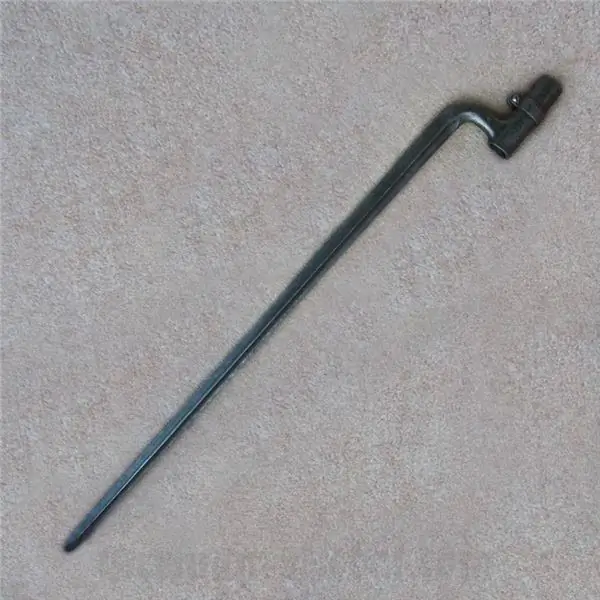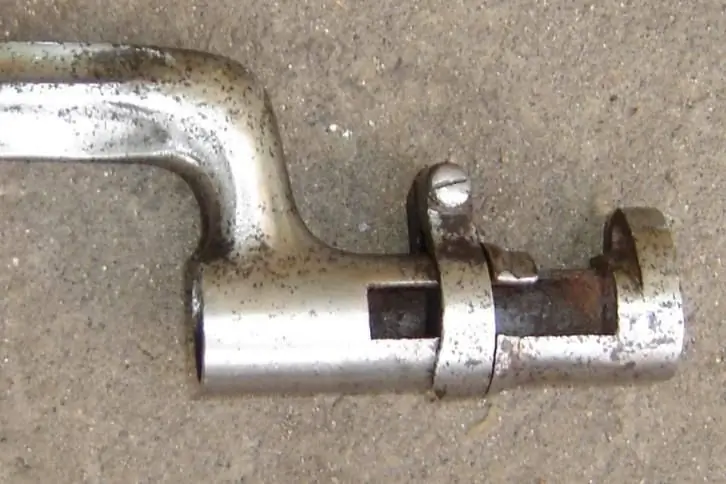- Author Matthew Elmers [email protected].
- Public 2023-12-16 21:49.
- Last modified 2025-01-24 09:17.
For a long time, small arms could not boast of high performance, which is why, after several shots, the armies had to switch to bayonet combat. This feature of the wars of the past is immortalized in the famous thesis of A. V. Suvorov: "a bullet is a fool, and a bayonet is a fine fellow." Later, more advanced weapons with improved characteristics appeared, which led to a noticeable reduction in the role of the bayonet in combat. In addition, an interesting consequence of this process was the fact that when considering various models of small arms, proper attention is not paid to bayonets. Let's fill this gap and consider several samples of bayonets used by our army in different periods.
In 1869, the Berdan rifle was adopted by the Russian army. This weapon was actively used by the army for several decades and only gave way to the so-called. Russian three-line rifle mod. 1891 (Mosin rifle). An interesting feature of the "Berdanka" was the use of a new needle bayonet, which later became the basis for several new designs used in later weapons. In addition, Berdan rifles of various modifications had different bayonets.

Berdan's rifle No. 1. Figure Kalashnikov.ru
Berdan infantry rifle arr. 1868 was equipped with a triangular bayonet, which in the future was repeatedly refined in order to change the characteristics and ergonomics of the weapon. The bayonet was attached to the muzzle of the rifle barrel using a tubular sleeve. This part had an L-shaped cutout in the side surface, intended for attaching the bayonet in the desired position using the so-called. bayonet rack soldered to the barrel. In addition, a metal clamp with a screw passed over the cutout. With this device, the base of the bayonet was supposed to grip the barrel and hold on to it due to the frictional force.
On the lower surface of the tubular sleeve, there was a bayonet support made in the form of one L-shaped part with the blade itself. For greater rigidity and safe handling, the elongated blade of the bayonet had a triangular shape without sharpening on the edges. The rigidity of the structure was provided by the grooves in the side surfaces of the bayonet. A characteristic feature of the bayonet for Berdan rifles, both No. 1 and later No. 2, was the sharpening of the blade. Its tip was made in the form of a narrow sharp plate, which made it possible to use the bayonet as a screwdriver. This feature of the bayonet greatly simplified the maintenance of the weapon with its complete or incomplete disassembly.

Berdan's rifle No. 2. Figure Kalashnikov.ru
The bayonet of Berdan's # 1 rifle reportedly had a 20-inch (510 mm) blade and weighed 1 pound (just over 400 g). The bayonet was supposed to be kept on the rifle at all times, with the exception of weapon maintenance operations. Zeroing was also carried out with a bayonet attached. Due to the relatively large length and weight, the blade had a noticeable effect on the firing characteristics of the rifle.
In 1870, the so-called. Berdan's rifle No. 2. She had a number of important differences from the first modification, as well as an updated bayonet. The main design features of the bayonet remained the same, and the method of attachment did not change, however, the shape and location of the blade were improved. Instead of a three-sided shape, it was decided to use a four-sided one, which provided greater rigidity and strength. To compensate for the derivation that occurs during the flight of the bullet, it was decided to move the blade from under the barrel to its right side. Thus, the bayonet with support was transferred to another part of the tubular sleeve, the design of which, however, did not change. As before, fastening to the muzzle of the barrel was carried out using a clamp with a screw.

Berdan rifle bayonet. Photo Germans-medal.com
The dimensions, weight and shape of the bayonet of the updated design, despite all the changes, practically did not change. All these parameters have already been worked out within the framework of the basic project, which made it possible not to introduce fundamental innovations while maintaining acceptable characteristics. The requirement regarding the constant operation of a rifle with a bayonet attached was also preserved. In this case, this requirement made it possible to increase the accuracy of the fire at the cost of some reduction in the ease of use of the rifle.
Berdanka # 2 was produced in several modifications: the troops received an infantry, dragoon and Cossack rifle, as well as a carbine. They differed from each other in various design features, including bayonets. So, an infantry rifle was equipped with a copy of the basic bayonet from rifle No. 1 with a changed position of the blade. The dragoon rifle differed from the infantry rifle in its smaller size, which was achieved, among other things, due to the design of the bayonet. The main difference of the latter was the reduced length of the support connecting the blade and the bushing. The Cossack rifle and carbine, in turn, were supplied to the troops without bayonets. This device was not intended to be used.

Bayonet from a different angle. Photo Zemlyanka-bayonets.ru
It is known about the existence of an alternative bayonet used by some army units. So, in the guards units, Berdan rifles were supplied, equipped not with a four-sided needle bayonet, but with a cleaver. The cleaver had the same attachments as the needle bayonet, but differed in the shape of the blade and in length. The cleaver rifle was half an inch longer than the needle bayonet weapon and also weighed 60 spools (255 g) more.
The bayonet of Berdan rifles of two modifications has proven itself well during operation in the army. Being a further development of previously existing ideas, already tested and worked out in practice, such a bayonet made it possible to effectively solve the assigned tasks. A rifle equipped with a needle bayonet was a versatile weapon suitable for firing at the enemy and using melee weapons in combat. In the case of the latter, the large length of the weapon and bayonet could give some advantage over the enemy with other weapons.

General view of the bayonet of a dragoon rifle. Photo Forum.guns.ru
In parallel with the creation of the Berdan rifle, and also for some time after its adoption into service, there were disputes among the army command about the prospects of the bayonet. Some military leaders suggested that infantry weapons be reworked along the lines of foreign countries. By this time, the Prussian army began to abandon needle bayonets and switch to cleaver bayonets, which had some advantages over their predecessors. Several times the controversy reached its peak, but the supporters of the needle structure managed to defend its preservation. Supporters of the cleavers still managed to "push through" such bayonets for the guards units, but the rest of the army, as before, had to use needle blades.
Also at that time, the issue of carrying and joining bayonets was considered. According to the manuals for the operation of the weapon, the bayonet had to be constantly on the barrel of the weapon, both during transportation and in battle. However, it was proposed to change this order based on ergonomic considerations. It was proposed to carry the weapon without a bayonet, which reduced its length and, as a result, affected convenience, attaching the blade only before the battle. According to some reports, even Emperor Alexander II was a supporter of such changes. However, even the support of the authorities did not help this proposal. Supporters of the existing approach to handling weapons have managed to defend it.

Bayonet attachment assembly. Photo Forum.guns.ru
Berdan rifles in infantry and dragoon modifications with bayonets of several designs were used by the Russian army until the end of the 19th century. After the start of the transition to the "Three Linear", the decommissioning of the obsolete "Berdanok" began, but a number of units continued to use this weapon over the next several years. Rifles taken out of service were sent to warehouses and became a reserve that could be used if necessary.
At the end of the eighties of the century before last, work began again on the creation of a promising weapon for the infantry. In this regard, proposals were again heard to switch to bayonets-cleavers, but the army command preferred to leave the existing structure, albeit in a modified form. In 1891, the Russian three-line rifle was adopted, which was equipped with a four-sided needle bayonet, based on the corresponding unit of the Berdan rifle. This allowed the needle bayonets to retain their place in the nomenclature of infantry weapons for the next several decades.






